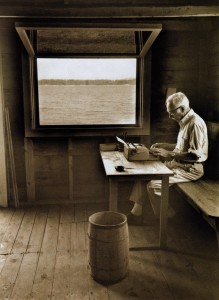
E.B. White in his boat shed overlooking Allen Cove, 1976 (photo: Jill Krementz from her book “The Writer’s Image: Literary Portraits” )
What’s NaNoWriMo, besides a tongue-twister? It’s short for National Novel Writing Month, a program that encourages writers to pour out a novel-length work in thirty days.
It’s not a contest but a popular, internationally known and very public test of a writer’s self-discipline. NaNoWriMo demands a commitment to write every day, no matter what, and to log your daily word count, which is then displayed on the NaNoWriMo website. The goal is to write a 50,000-word (approximately 175-page) novel between November 1 and midnight on November 30.
Writers of memoir, and fiction based on life experiences, can participate too.
NaNoWriMo worked for me, three times. I learned to ignore those bully priorities whose egos had eclipsed my will to write, and for one month, I would hunker down for a minimum of eight hours a day to write. It was difficult, and at times even boring.
But, in those thirty days I found many of those moments that writers fantasize about when they aren’t writing. The moments when writers discover themselves in their pages, living their stories, interacting with their characters — those coveted instances when the words just come and come, elegantly, smoothly, and powerfully.
For writers who want to write but just never manage to find the time, or who have been blocked for longer than they care to admit, NanoWriMo is a terrific motivational experience. If you do it right, by the end of that thirty days you will have a first draft of a manuscript in hand. You will have found your words.
The following tips may help you to avoid some of the pitfalls I encountered in my NaNoWriMo days.
1.
Sign up. I know it seems obvious, but it is the first step in the commitment to sit down and do it. Go to www.nanowrimo.org to register.
2.
Build your profile page on the NaNoWriMo site right away and promote it any way you can — including via Facebook/Twitter if you’re on social media. This serves two purposes: a) It begins the process of accountability for the words you must write, and b) It will explain to friends, family, and colleagues why you WILL BE ignoring them for the month of November.
3.
Establish your theme, and one main character, your setting, and at least two plot points. If possible, have an ending in mind (though that may change as you go along). Record it in your NaNoWriMo novel’s description. This is your kindling.
4.
Give your manuscript a working title, but don’t worry about it further. Titles always change.
5.
Start writing. Right away. Day 1 counts. Days 2 through 30 also count. There is no catching up later. You must write every day and record your word count every day, even if it is shameful!
6.
Post a note on your refrigerator door, one on your office wall, and another next to your bed or in your bathroom. I must write 2,000 words today. This is your mantra.
7.
On hand you should have healthy, and some fun, ready-to-eat snacks. Quick meals are a necessity. There is no nobility in cooking a meal that requires four days of preparation during NaNoWriMo. Don’t give yourself the opportunity to procrastinate in any manner. (Believe me you will try.) For these 30 days your creativity should be channelled ONLY through your writing.
8.
Take a walk every day. Clear your mind, take a mental break, and focus on breathing. You will reset your creativity and find the much-needed energy required to continue.
9.
Do not post more than a short excerpt of your story on your public profile. This first draft of your new novel is yours. Protect it. I don’t post entire works anywhere as a rule of thumb. Go ahead and brag about your word count, however; post it all over your social media sites. The pride you feel will be converted into motivation for the next day’s writing.
10.
Coffee. Need I say more?
* * *
 STACEY NEWMAN’s articles, stories, and photographs have been published in over 30,000 publications and websites around the world, and her first novel, The Beauty of the World (2006), received critical acclaim. Since 2011, she has been a contributing editor and photographer for publications in Halton Region, and she is Editor-in-Chief for MOM Magazine, published by JONA Marketing of Milton. She has worked for local media and business content developers for close to twenty years, and for four years ran an award-winning small literary press she established with her husband, Stephen.
STACEY NEWMAN’s articles, stories, and photographs have been published in over 30,000 publications and websites around the world, and her first novel, The Beauty of the World (2006), received critical acclaim. Since 2011, she has been a contributing editor and photographer for publications in Halton Region, and she is Editor-in-Chief for MOM Magazine, published by JONA Marketing of Milton. She has worked for local media and business content developers for close to twenty years, and for four years ran an award-winning small literary press she established with her husband, Stephen.
Stacey is also an iStockphoto and Getty Images stock photographer and a contract commercial photographer. Professional photography has become a second career path that she finds an exciting complement to her storytelling. When she isn’t behind a computer or a camera, she is an avid outdoors woman and aviation enthusiast. Stacey travels often with Stephen, a pilot and also a photographer himself, and brings what she learns in her travels to both her writing and photography. Born in Montreal and raised in the Toronto area, Stacey is now a proud resident of Milton, Ontario.